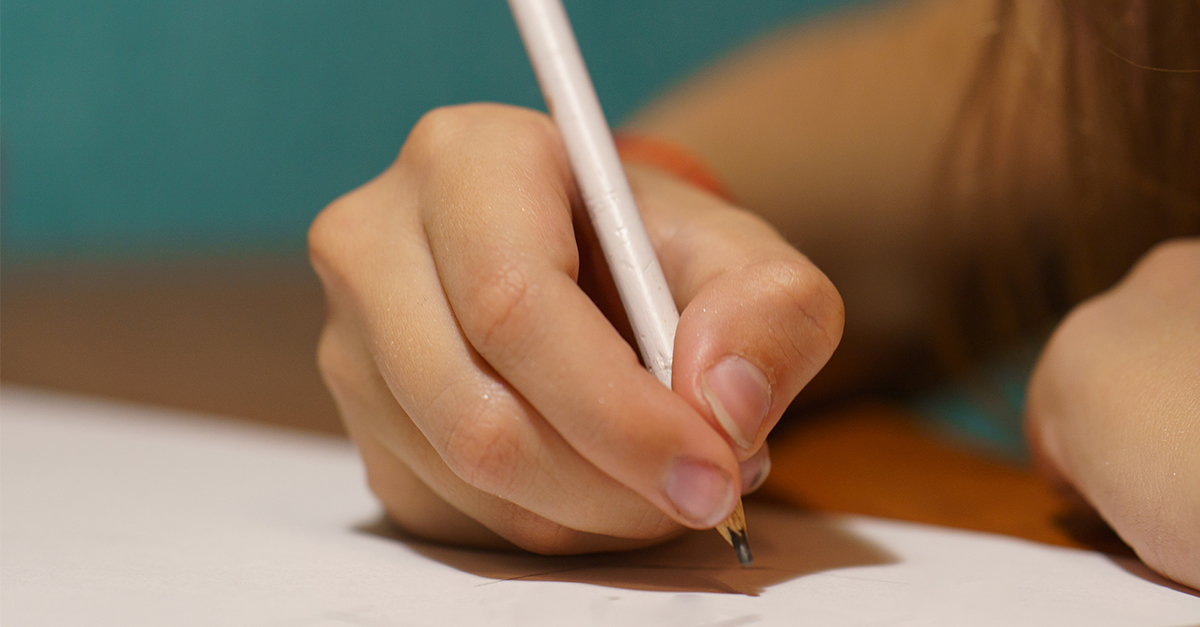
Do you remember the scene from one of the Charlie Brown cartoon specials where Miss Othmar asks the class to take out pencils and paper for a dictation? She then proceeds to “dictate” to the class, but all you hear is “Wha, wha, wha wha whaaaa.” This scene is what I so often recall when someone says the word “dictation” to me. I was never much of a fan of dictation. In fact, I vividly remember the out- of-body experience of my first dictation in third grade. The teacher, Mrs. Strunk, said, “Take out your pencils and a sheet of paper,” and I probably experienced my very first full-blown panic attack!
Why, you ask, in this 21st century academic environment, would we see value in using dictation as a tool for mastery in Spelling You See? Perhaps it would be best to define what dictation is perceived to be, and what it actually IS – especially in terms of a Spelling You See experience.
Many of you had dictation experiences in your school years. You probably remember trying to recall the whole of the sentence your teacher had just carefully articulated to you. You may or may not have had stellar success with the process. If you found it an easy task, then you may wonder why a student would balk at the idea of doing it. If you found it to be anxiety-provoking, as I did, then you may wonder why on earth you would want to put your child THROUGH that?

The value of dictation in Spelling You See cannot be overstated. This is the way your student provides you with feedback as to their progress in developing their visual spelling memory. Here are some very critical points about Spelling You See’s dictation that will be different from what you remember your dictation experiences to be:
1. It is not possible to provide too much help in the first dictation of the week. This is a process, and your encouragement of your student’s progress will be vital to his or her success. If they have misspelled a word and seem to be struggling, it is perfectly acceptable to show them the word in the dictation passage and then ask them to try it on their own. The important thing is to keep this a positive, affirmative experience.
2. Timing is everything. Ten minutes is chosen for a reason – developmentally, you are asking your child for a good deal of output, so you want that output to be time-limited.
3. Their functional spelling DOES improve, but over time. Keep it positive; keep it F-U-N. Smile and cheer them on and remember, “even the snail got to the ark”.
4. Word-by-word dictation is essential. You want to correct the errors as they occur. Correction after the fact is so much less effective as to almost make it not worth it. Stay with your child in the moment as they progress.
5. No zingers! There is no downside to teaching spelling this way. Any child who has struggled with spelling will wonder when you are going to drop the other shoe on them. If you say, “I am not interested in what you spell wrong any more, but I want to encourage you as you spell words correctly,” this is be beginning of a huge paradigm shift for them.
6. Remember it is not how MUCH they complete but how many words they spell correctly. The length of a successful dictation increases over time. Dictation becomes gradually easier, and eventually your student will write more words correctly.
“So how do I know it is working?” We get asked this question frequently. Over time, you will see that your student’s accurate dictation improves, and they complete more of the dictation in any given passage. The golden ticket will be when you see his or her spelling improve in their compositional writing. Then you know you are truly achieving the goals of Spelling You See.




Hi Gretchen! You seem like my kind of person with loving the outdoors, all things furry and learning farming and beekeeping! How effective is Spelling You See for a 12 year old that has Dyslexia?
Spelling You See is a fantastic program, especially for a child with dyslexia. One of the greatest challenges with a dyslexic child is that they lose confidence in their own capacity to do things that are reading and spelling related. How beneficial it is to have a program that celebrates what they ARE doing right and then asks them to do more of the same! Spelling You See seeks to create that visual recognition for word pattern that is so often a missing component for dyslexic students. And the added benefit that the program is designed to be of brief duration for the student means that you can, in Dr. Holinga’s words, “get in and affect a positive improvement and then get out again before the child becomes stressed.” I would encourage you to speak with one of our representatives to help with placement, as we will have some specific questions for you. In fact, if you would like, it would be my pleasure to help with that. You can call me at 717.524.5692. – Gretchen
What if you’re using Spelling U See exactly as recommended, but are not seeing an improvement in spelling in areas outside of Spelling U See, such as journal entries or essay composition?
Please remember that this is a process, and every student’s progress is different. The Skill Development stage takes as long as four to four and a half years to negotiate successfully. You may not see progress immediately. I would also encourage you to reach out to our customer service team [1-888-854-6284] and allow them to help you do some one-on-one troubleshooting. There may be other questions they can ask that would help to determine why the progress is slow.
Will do that, thank you!